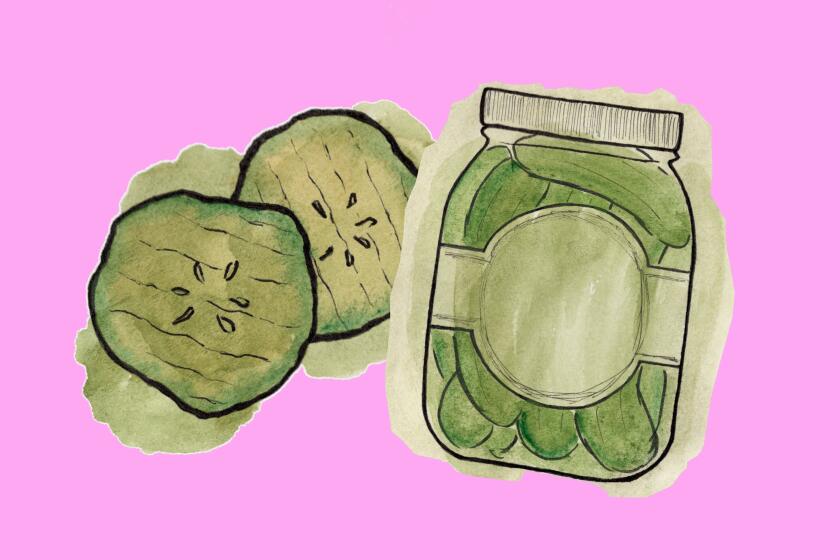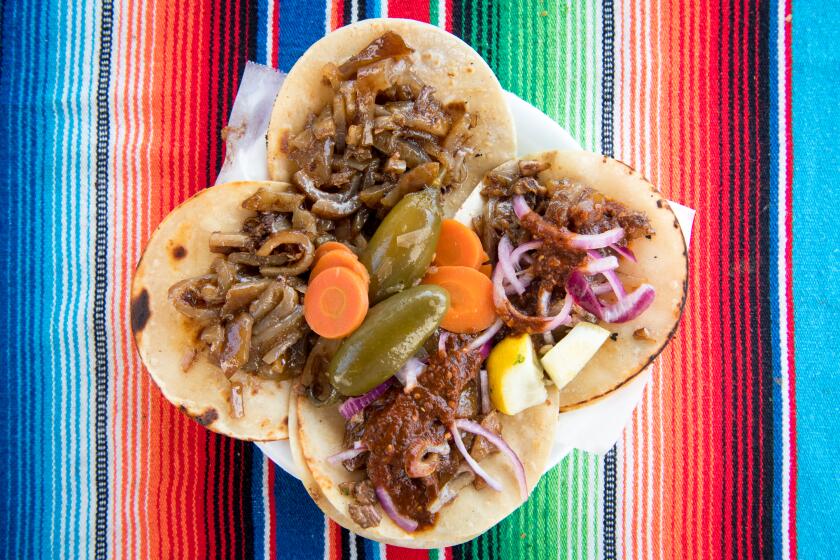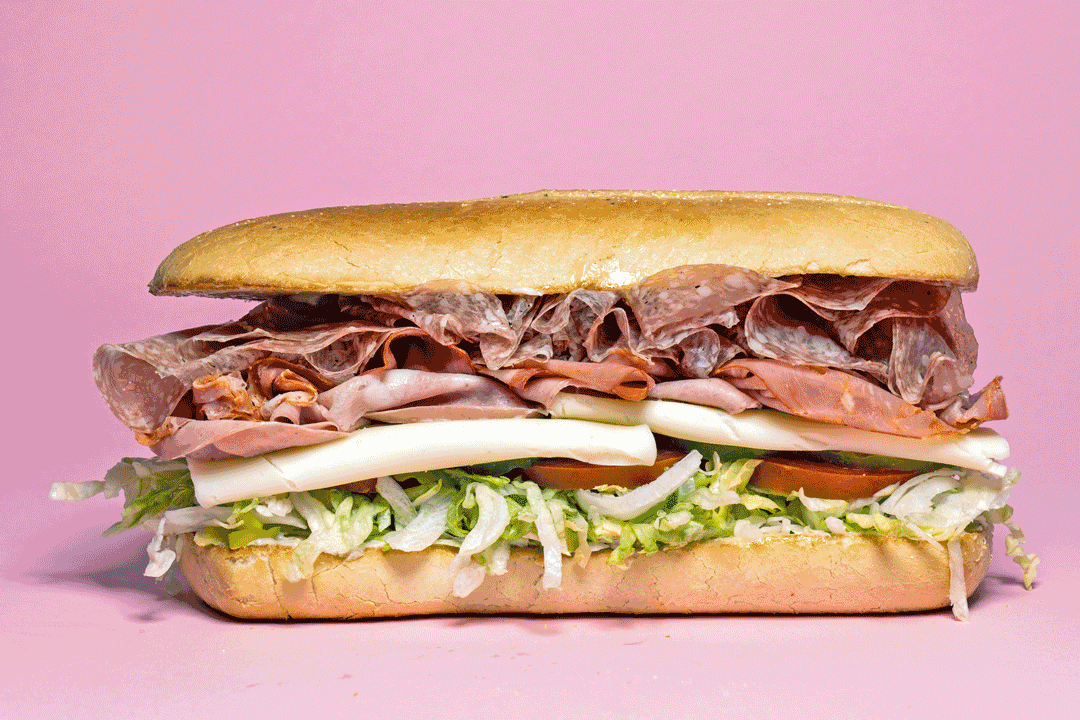Love pickles? Where to find kosher dills, herring, kimchi and more
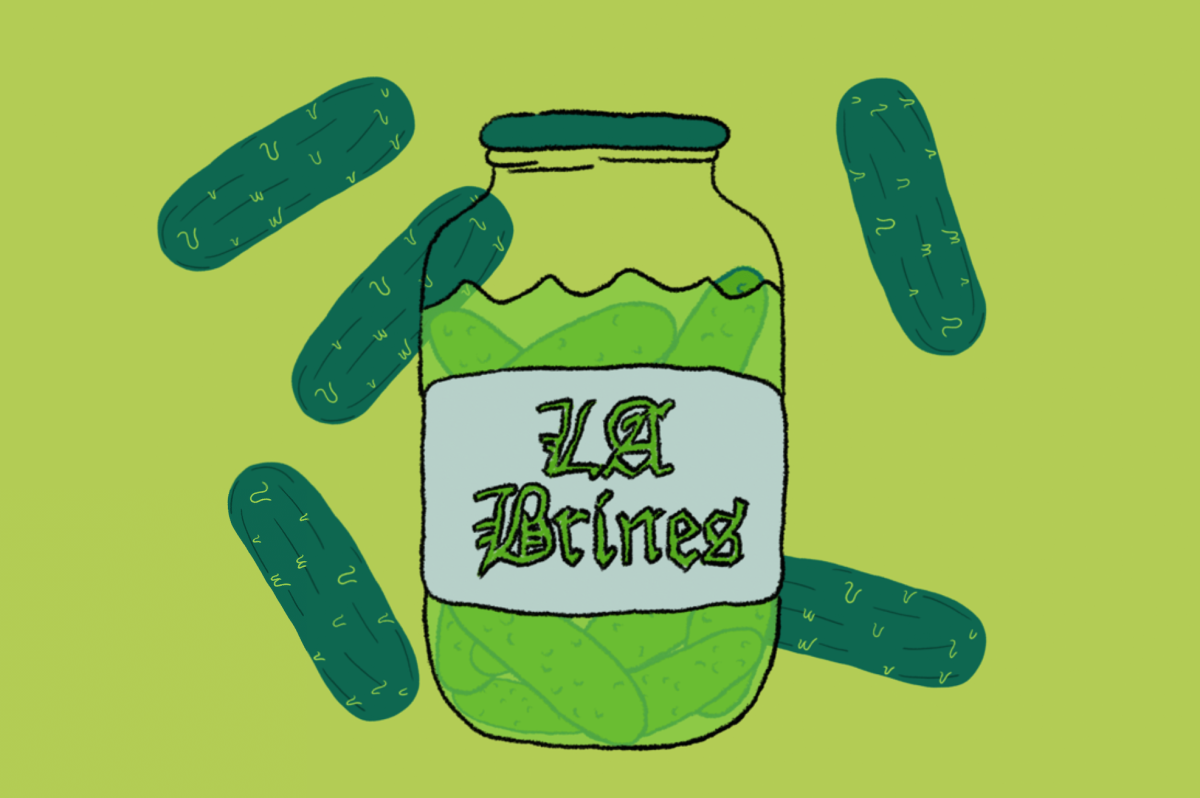
- Share via
Pickles are a testament to the ingenuity of various cultures around the world — people who figured out early on that they could preserve food for the weeks and months ahead.
Historians believe the ancient Mesopotamians were pickling as early as 2400 BC. Cleopatra and Julius Caesar were fans. Christopher Columbus sailed across the Atlantic with pickled food, and scholars believe Shakespeare helped to popularize the phrase “in a pickle.”
Originally created as a way of preserving foods, the pickling process also adds delicious funk and dimension to vegetables, fruit and spices that are treated with vinegar, salt or a variety of other materials.
Which leads us to the current pickle boom in the United States. Last year, about 241 million Americans consumed pickles — not quite 75% of the population (and 4.67 million Americans consumed more than six jars of pickles each), according to U.S. Census data.
Lucky for us, there’s a pickle component in almost every culture around the world, and many are represented in Los Angeles. From pickled tomatoes to herring, here are some of our favorites.
Kosher dills
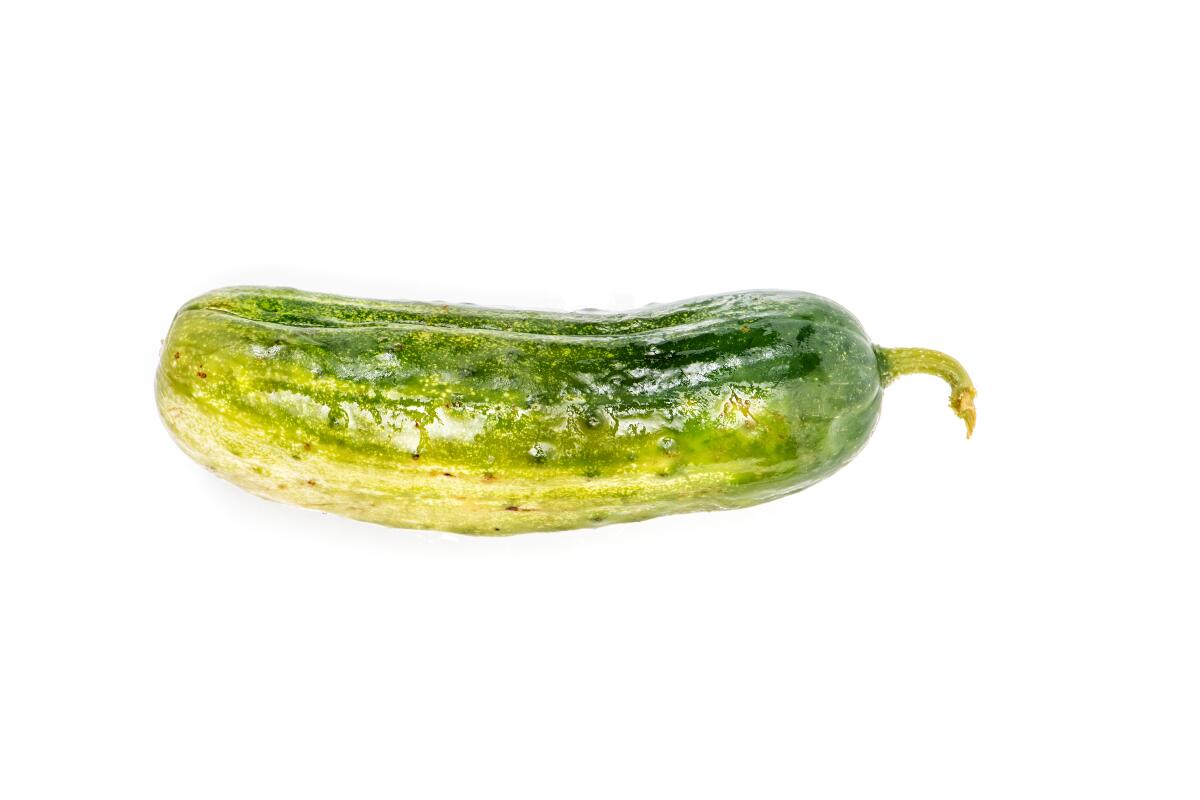
Nate’n Al’s deli in Beverly Hills goes through multiple 50-pound barrels of pickles each week when fully operational. And all those half sours (also known as new pickles) and full sours come from A1, a local pickle producer in Los Angeles.
Arthur Sherman, head of restaurants for Azoff Restaurant Group, the company behind the deli, says kosher dill pickles and delis have been intertwined since an influx of European Jews settled in New York City in the late 1800s. The pickles were made by filling wooden barrels with cucumbers, kosher salt, dill, garlic and water.
“We sort of use them as an amuse-bouche,” he said, referencing the complimentary plate of pickles people receive when they dine in the restaurant. “It’s a fun way for people to start off their deli experience, and there’s nothing better than eating a pastrami sandwich with a side of pickles.”
Nate’n Al’s deli, 414 N. Beverly Drive, Beverly Hills, (310) 274-0101, natenals.com
Sauerkraut
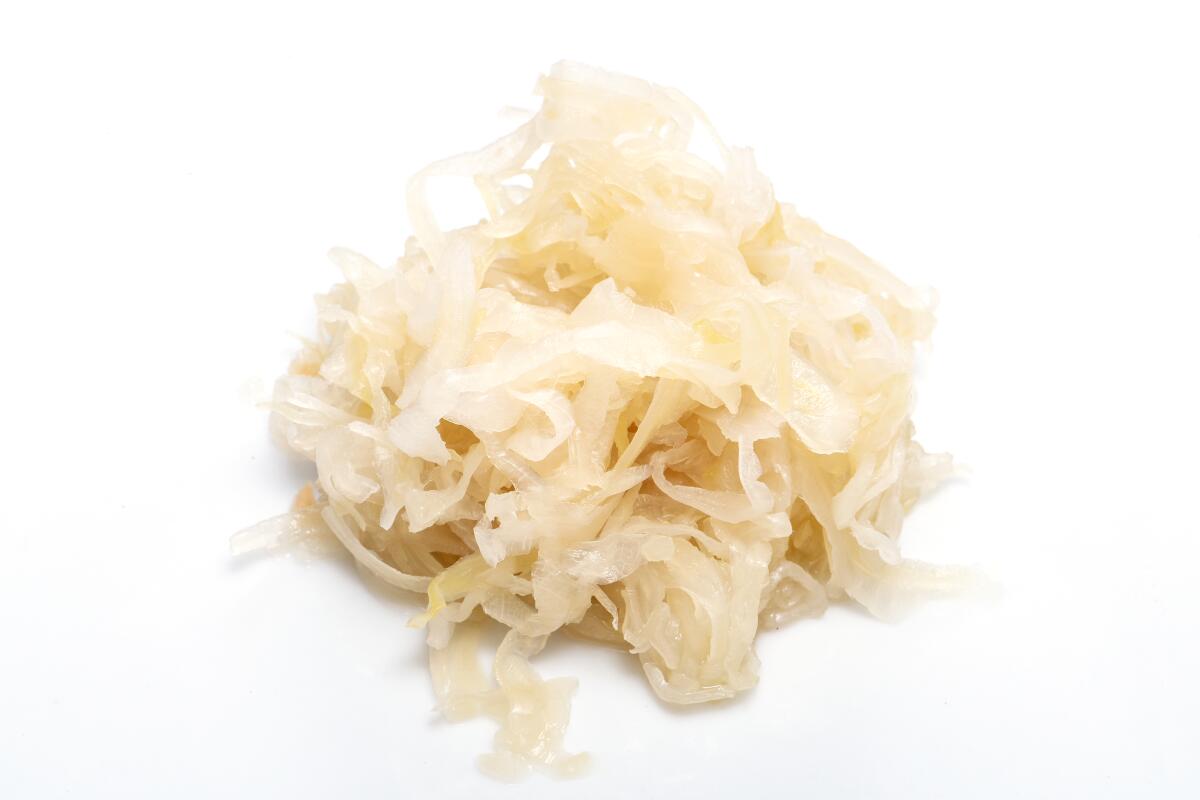
Sauerkraut, which comes from the German words sauer (sour) and kraut (cabbage), has been a traditional part of the German diet since the 17th century. And it’s a tradition that endures locally in a sauerkraut factory in Elysian Valley.
“Sauerkraut is cabbage and salt, nothing else,” Kruegermann Pickles co-owner Greg Kruegermann said. His family has been making sauerkraut since the late 1800s in Germany, moving the operation to Los Angeles in the 1960s. They make it in large tanks and use granite rocks to weigh down the cabbage. It’s the only sauerkraut that Wally Schreiner, owner of the nearby Schreiner’s Fine Sausages in Glendale, will serve on his bratwurst.
“We use it on all of our hot sausages,” Schreiner said. “And when we warm it up, it just adds the perfect complementary flavor.”
Schreiner’s Fine Sausages, 3417 Ocean View Blvd., Glendale, (818) 244-4735, schreinersfinesausages.com
Gari
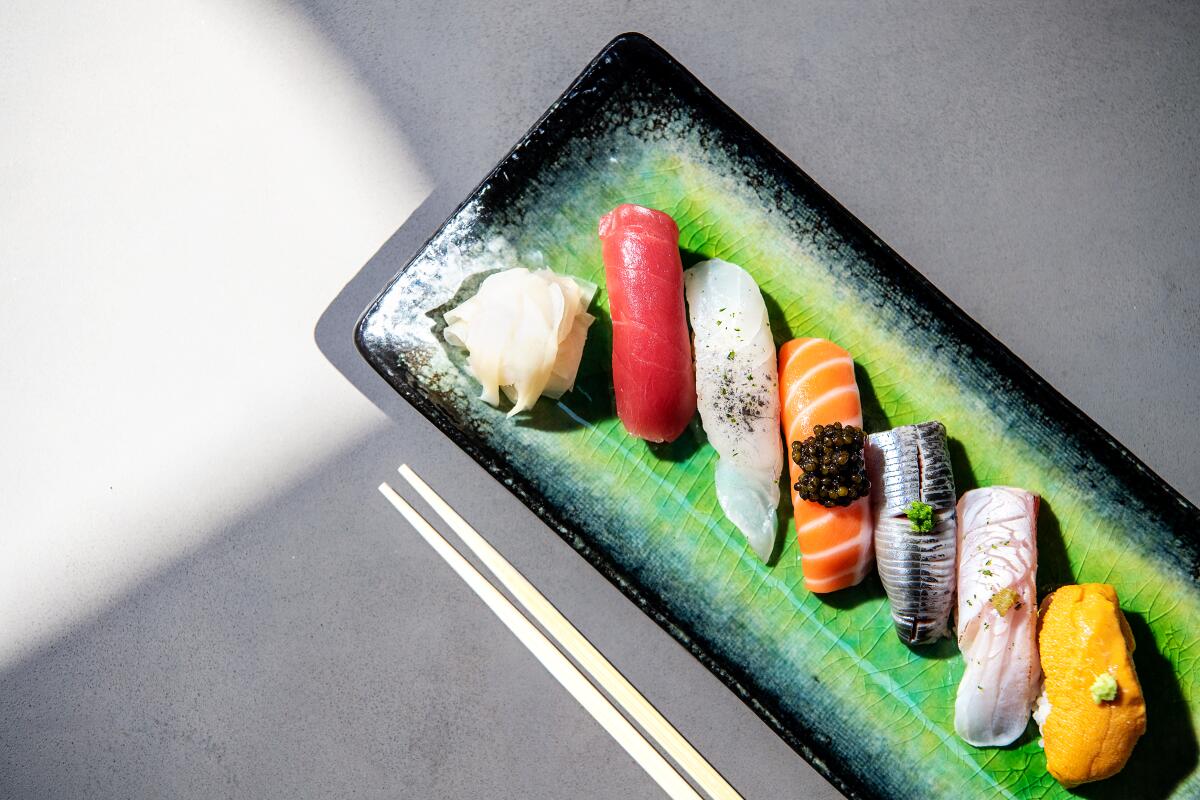
Pale yellow and sometimes pink slices of pickled ginger, a type of tsukemono (Japanese pickle), have been served alongside sushi for centuries as a palate cleanser. They are typically made from the young ginger, called shin shoga, that is in season during the spring.
The Brothers Sushi chef-owner Mark Okuda says he can’t regularly make his own gari at his Woodland Hills restaurant, because he goes through about 40 pounds of ginger a week. But when he does make it, he cubes the ginger and steams it before soaking it in amazu, a sweet vinaigrette made from sugar, rice vinegar and salt.
“You have a slice after you enjoy a strong-flavored fish,” said Okuda. “For example, [after] smoked bonito or a fishier fish such as mackerel.”
The Brothers Sushi, 21418 Ventura Blvd., Woodland Hills, (818) 456-4509, thebrotherssushi.com
Pickle tips from Porridge + Puffs chef Minh Phan, Birdie G’s chef Jeremy Fox, pickle workshop instructor Jessica Wang and Dr. Arielle Johnson.
Pickled tomatoes
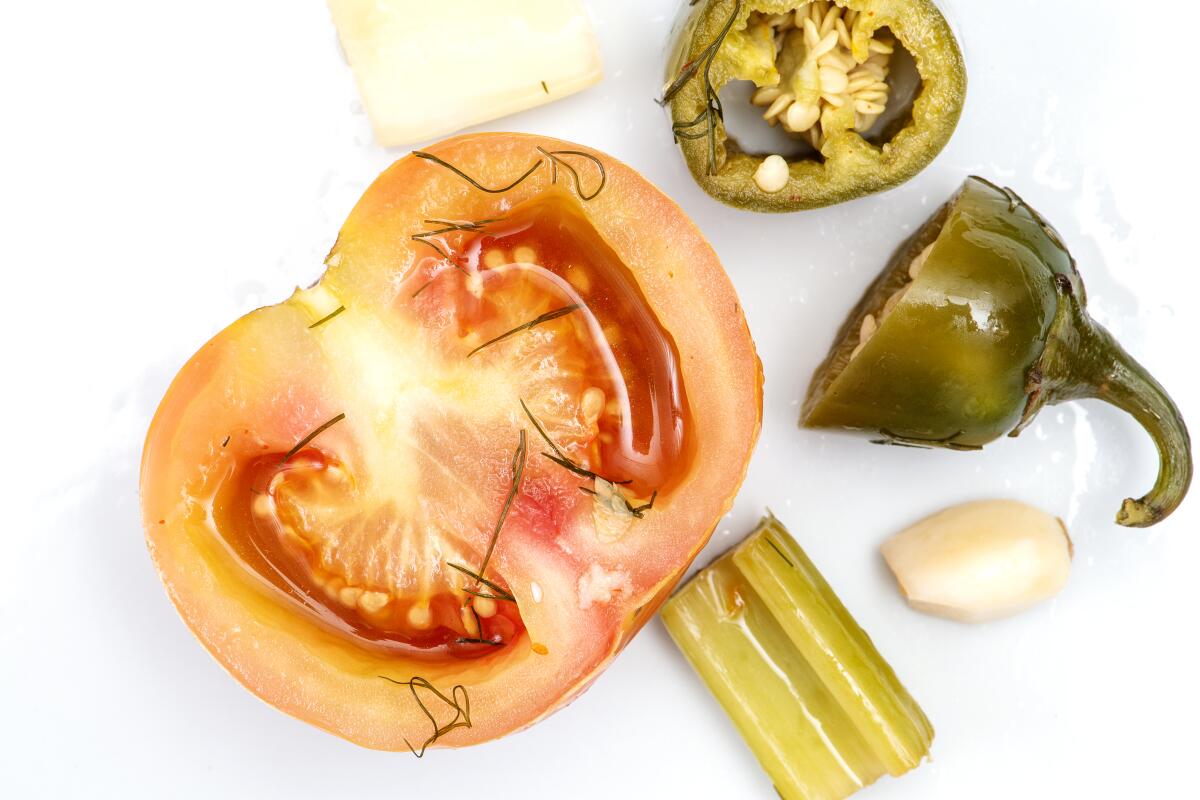
“The Russians pickle everything from radish to cabbage to carrots to anything,” Traktir co-owner Oleg Atroshenko said. “Fresh vegetables and fruits were only available certain months of the year, so people would pickle [them] for the winter.”
The West Hollywood Russian restaurant and market sells all kinds of pickles but the tomatoes are the most popular. They are made by layering celery, garlic, dill and jalapeño in the bottom of a jar, then adding halved tomatoes. The layers are repeated until the jar is full. Then water, sugar, salt and red wine vinegar are added and the pickles are left to sit at room temperature for two to three days.
The bracing acidity yields to the flavor of a sweet, ripe tomato as the juices drip down your chin. Atroshenko suggests eating the tomatoes as a chaser to meat or after a good strong shot of vodka.
Traktir, 8151 Santa Monica Blvd., West Hollywood, (323) 654-3030, traktirla.com
Cornichons

Ludo Lefebvre serves each Croque-Monsieur, Croque-Madame, jambon beurre sandwich and order of steak tartare at Petit Trois le Valley in Sherman Oaks with a few cornichons. The pickled gherkins are commonly found in England and France, pickled with vinegar, salt, herbs, garlic, clove and peppercorns.
Lefebvre also makes a charcuterie sauce with cornichons to serve with pork chops. Because it’s hard to find gherkins locally, he buys his cornichons from France.
“They are made to be eaten mostly with charcuterie, sandwiches and the like and can even be featured in sauces,” Lefebvre said. “The acidic flavors and crunchy textures provide a nice balance to sometimes fatty or rich charcuterie.”
Petit Trois le Valley, 13705 Ventura Blvd., Sherman Oaks, (818) 989-2600, valley.petittrois.com
Taco truck pickled jalapeño and carrot
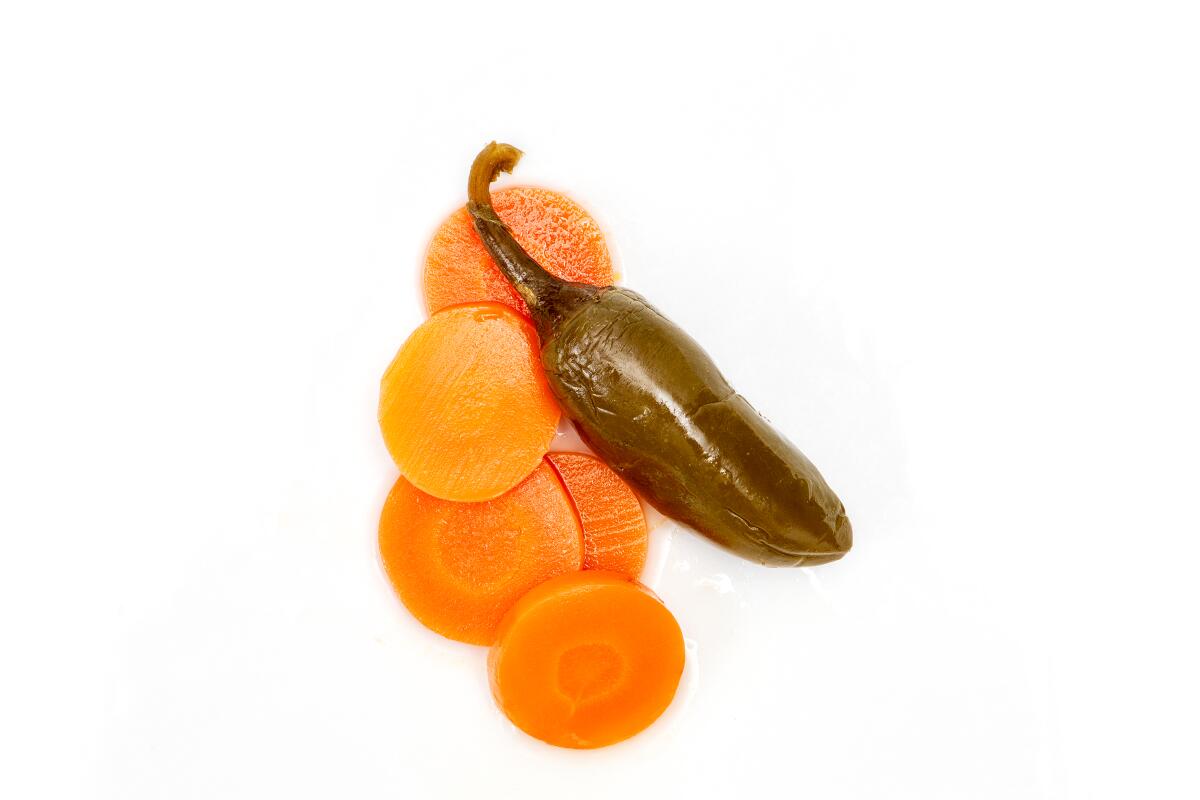
Carnitas El Momo co-owner Adriana Acosta says serving tacos with pickled jalapeño is just how it’s always been. Her father, Romulo Acosta, started making carnitas in Guanajuato, Mexico, in the 1950s, and it’s traditional, she said, to “eat carnitas with the juice of the jalapeño.”
“That’s all it needs.”
Acosta uses the Carey brand of whole pickled jalapeños and sliced carrots. The whole jalapeño makes it easy to dribble the pickling liquid onto the heaps of chopped maciza (shoulder), buche (stomach) and cuerito (skin) in the carnitas mixtas tacos. The juice zips through the rich meat, amplifying the pork with a sharp heat.
From food trucks and a weekend restaurant in Boyle Heights, Romulo “Momo” Acosta and his family serve what are arguably the finest carnitas in Los Angeles.
Carnitas El Momo, 2411 Fairmount St., Los Angeles, (323) 627-8540, instagram.com/carnitaselmomo
Barbecue pickles
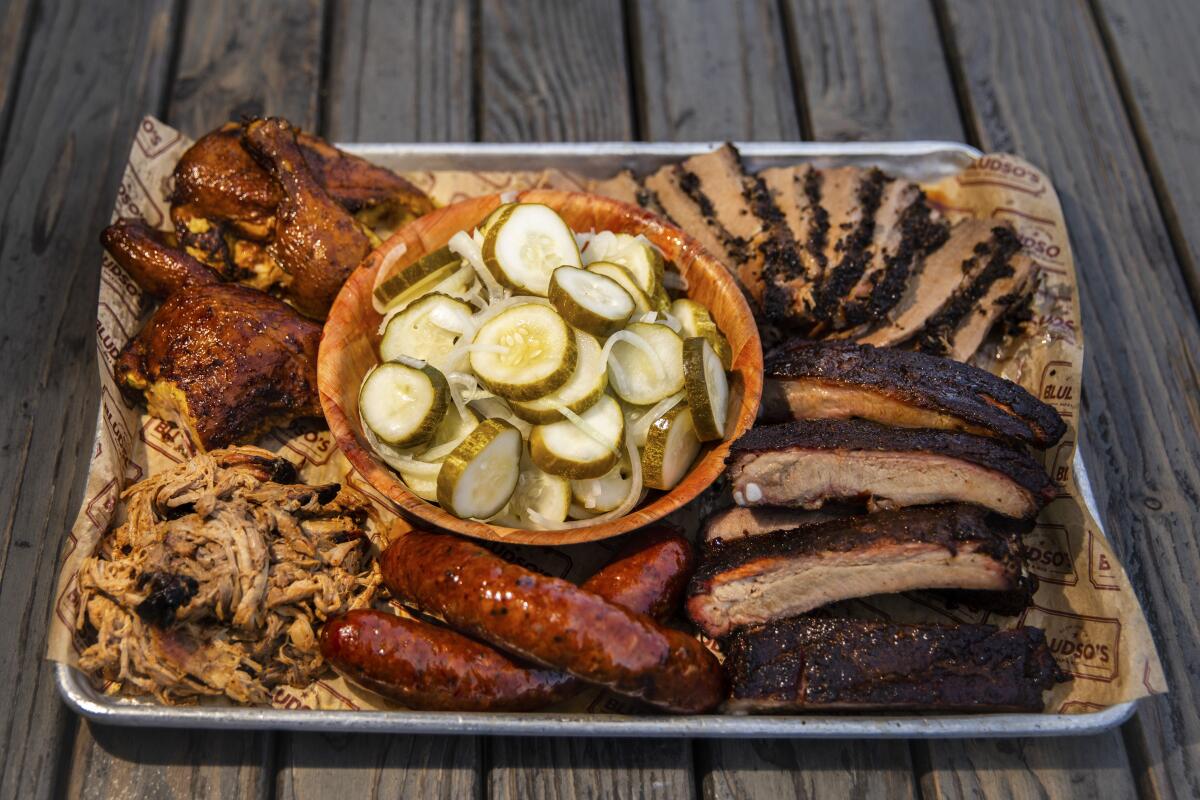
Bludso’s Bar & Que owner Kevin Bludso believes a mound of pickles is essential to any tray of Texas barbecue.
“Back in the day, a lot of barbecue in Texas was served as a sandwich [with] onions, peppers and, of course, pickles on the side,” he said. He’s a firm believer in eating pickles with all Texas barbecue but thinks they pair especially well with brisket sandwiches.
“They’re just a classic thing to go along with classic Texas barbecue, along with white bread and onions, because they were mostly shelf-stable,” he said. Bludso makes his own quick pickles with vinegar, salt, sugar, garlic, dill, mustard seed and pickling spice.
Bludso’s Bar & Que, 609 N. La Brea Ave., Los Angeles, (323) 931-2583, barandque.com
Pickled turnips
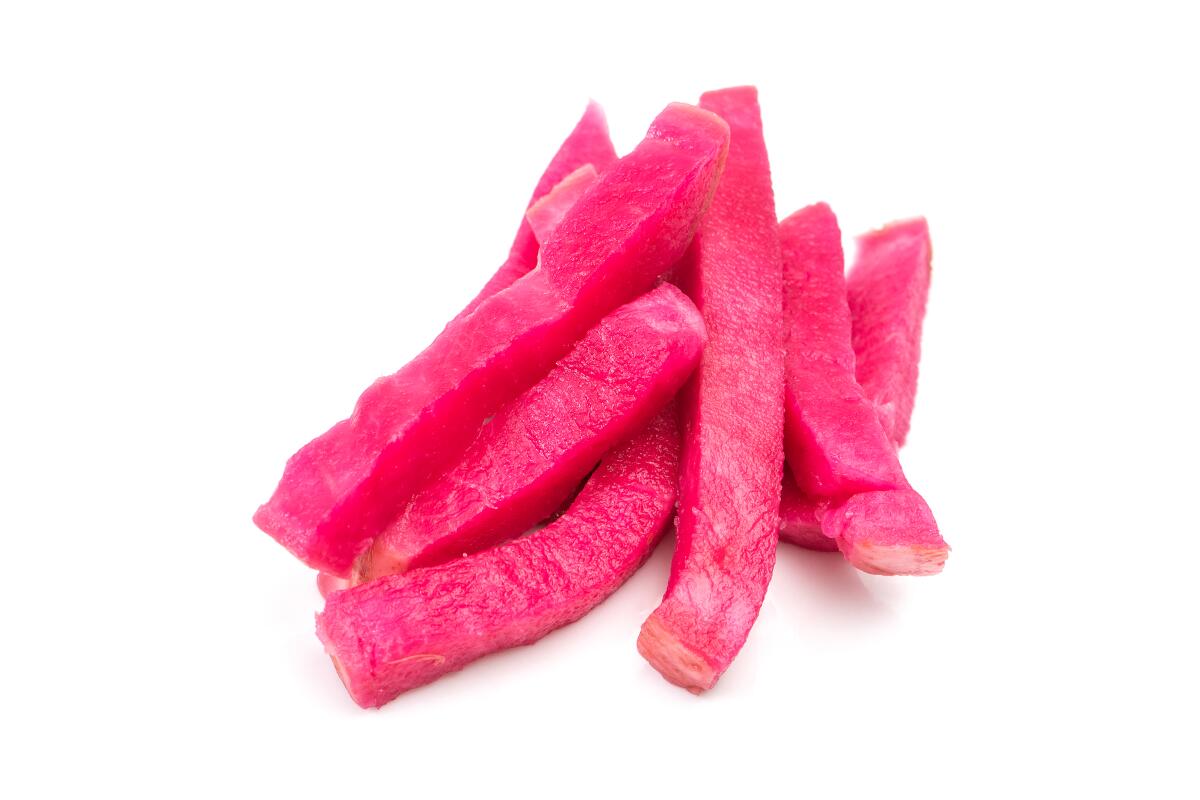
Koko’s Mediterranean Cafe co-owner Aline Bogharian calls pickled turnips “the pickles of the Middle East.” She can’t pinpoint exactly when they migrated to the Levant region but believes “they have been perfectly paired with our traditional dishes for as long as we can remember.”
Growing up in Lebanon, she often ate pickled turnips wrapped into shawarma and falafel sandwiches. “They provide a crunchy, slightly spicy, sour punch to contrast and enhance the flavor of chicken or falafel,” she said.
The turnips at her Pasadena restaurant are pickled with distilled vinegar, citric acid, water, salt, chile peppers and garlic. Beets are added for that signature pink hue.
Koko’s Mediterranean Cafe, 273 Shoppers Lane, Pasadena, (626) 793-8844, kokosmediterraneancafe.com
Sichuan pickled cucumbers
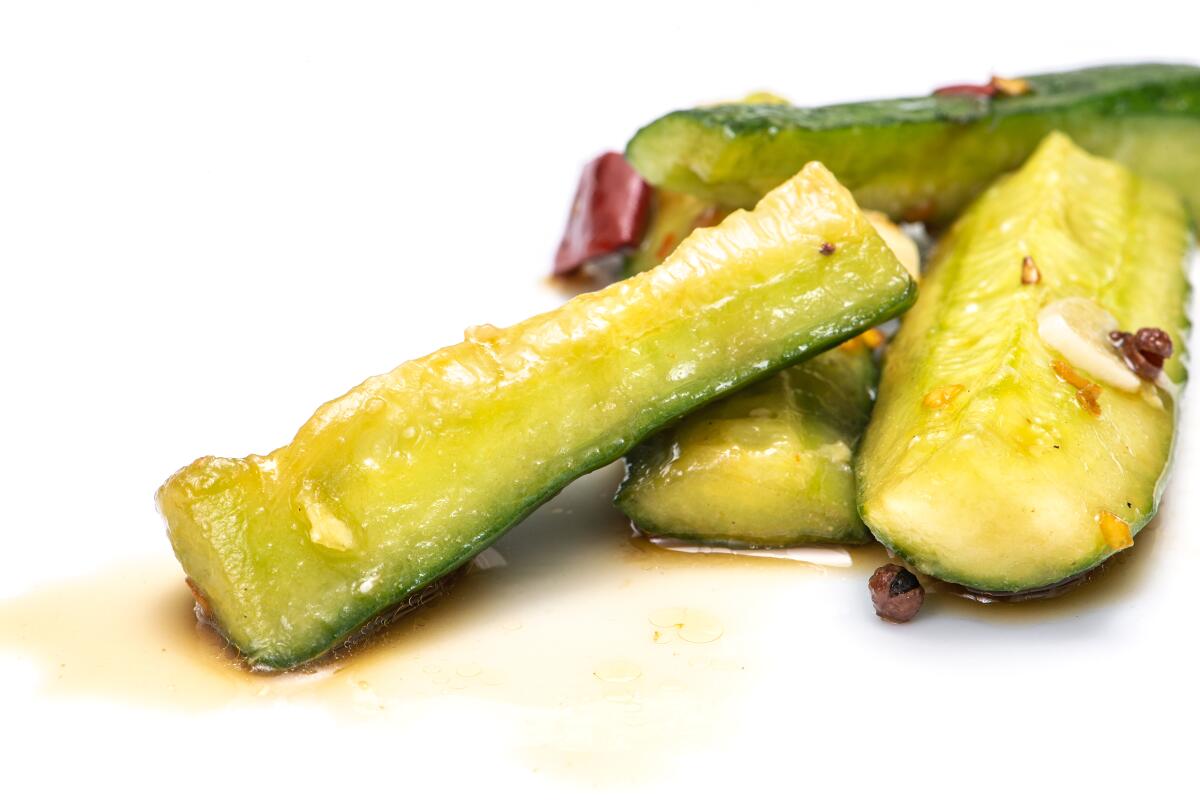
Sichuan Impression co-owner Kelly Xiao likens pickled dishes in Sichuan to dinner salads in America. Anyone from the region has had Sichuan pickled cucumbers “many times.”
“As an appetizer, it has the important role of opening up your taste buds,” she said. “It’s also a palate cleanser.”
The process to make the “grandma’s pickled cucumbers” at Sichuan Impression takes around three days and involves a high ABV (alcohol by volume) liquor used to remove any aftertaste from the raw baby cucumbers. The vegetables are generously salted and left to sit for at least 30 minutes to draw out the moisture. The liquid is drained, and the cucumbers are glossed with hot chile oil, garlic and Sichuan peppercorns. Then they’re covered in a mixture of spices, salt, sugar, vinegar and soy sauce.
The cucumbers retain their crunch under the salty, fiery liquid. And around the third bite, the ma la kicks in.
Sichuan Impression, multiple locations, sichuanimpressions.com
Achaar
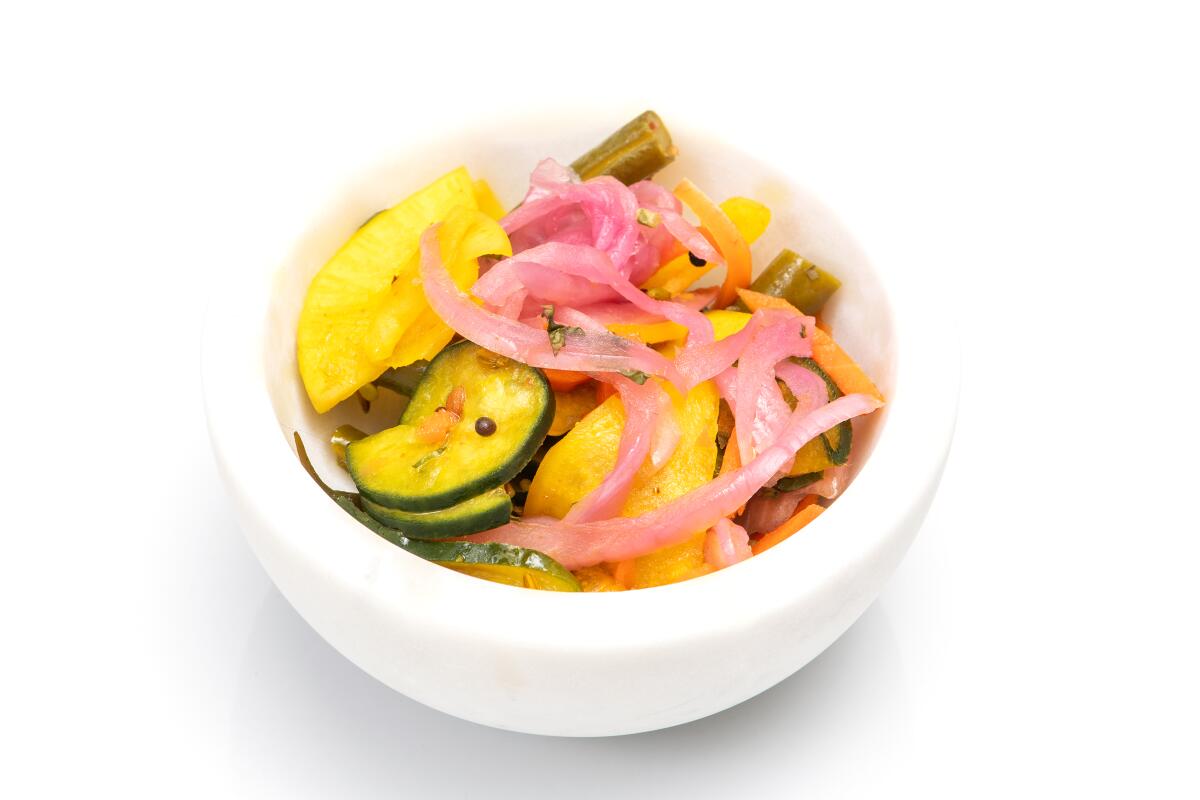
The word “achaar” means pickle in Hindi, and Badmaash co-owner Nakul Mahendro says every region in India is known for a different kind. His family’s favorite: chundo, a sweet mango pickle from Gujarat.
“Usually achaar is cooked on a stove or naturally in the heat of the sun,” Mahendro said. “Their flavors can range from candy-like sweet to highly acidic and tart.”
At the Badmaash restaurants in Fairfax and downtown Los Angeles, Nakul’s father, Pawan, makes what he calls a cross between a traditional achaar, made with spices and oil, and a European-style pickle, made with vinegar. Pawan heats the spices and cooks the vegetables until they’re just softened. Then he adds them to a hot brine to sit for a couple of days. Each vegetable has its own spice mix: red chile for the carrots, cumin and turmeric for the cucumber. The pickles flood your mouth with the pungent pickling liquid, resetting and shocking the senses (think the food equivalent of the lighting bolt emoji).
Badmaash, multiple locations, badmaashla.com
Giardiniera
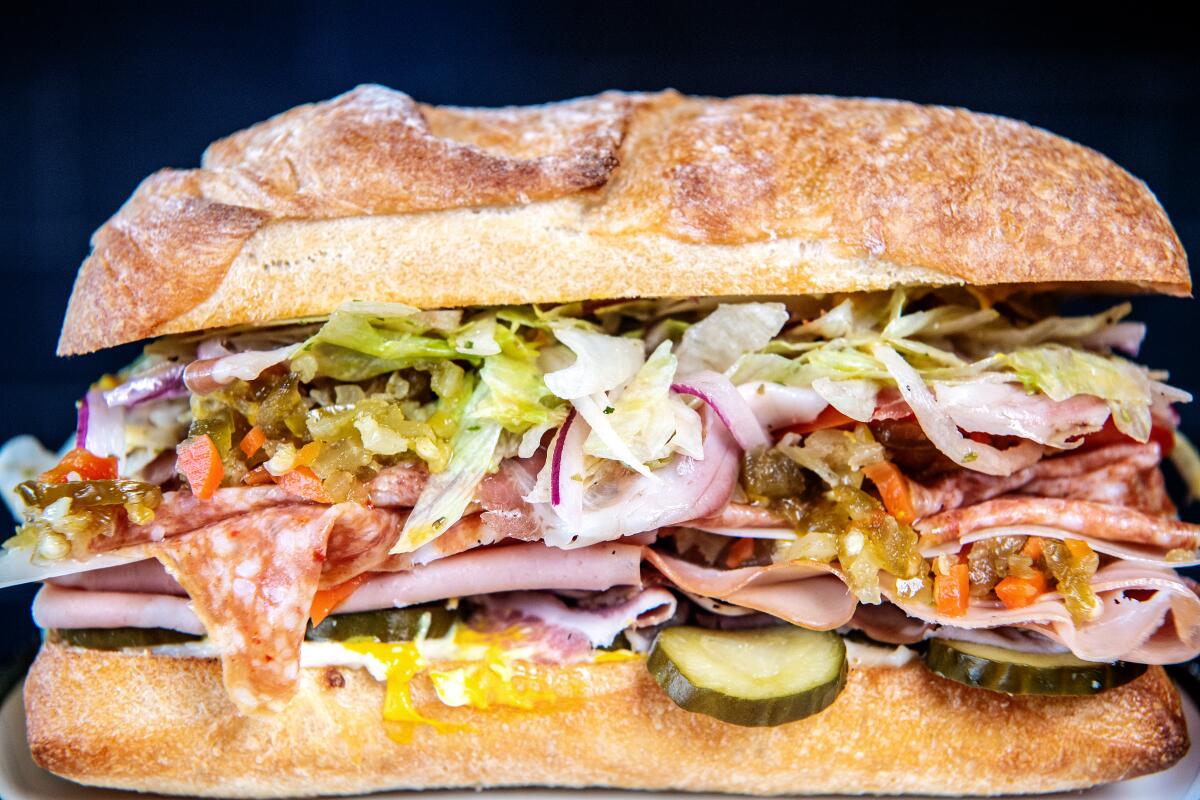
The Italian mixed pickle condiment is typically made with cauliflower, carrots, celery and chiles. While it originated in Italy, it’s especially popular in Chicago, where the spicy, tart vegetables are used to top Italian beef sandwiches and subs. The word giardiniera actually means “female gardener” in Italian.
“It’s the perfect foil for the rich meats and crusty bread on an Italian hoagie,” Cosa Buona chef Zach Pollack said. Pollack uses the hot Marconi brand giardiniera relish on the Stepmother sandwich at his Echo Park restaurant. The minced vegetables are soaked in oil and vinegar, adding just the right amount of spice and moisture to the sandwich.
Cosa Buona, 2100 Sunset Blvd., Los Angeles, (213) 908-5211, cosabuona.com
Grinder, hoagie, hero, sub, torpedo. The name differs based on where you’re eating it. In L.A., to most, it’s an Italian sub.
Kimchi
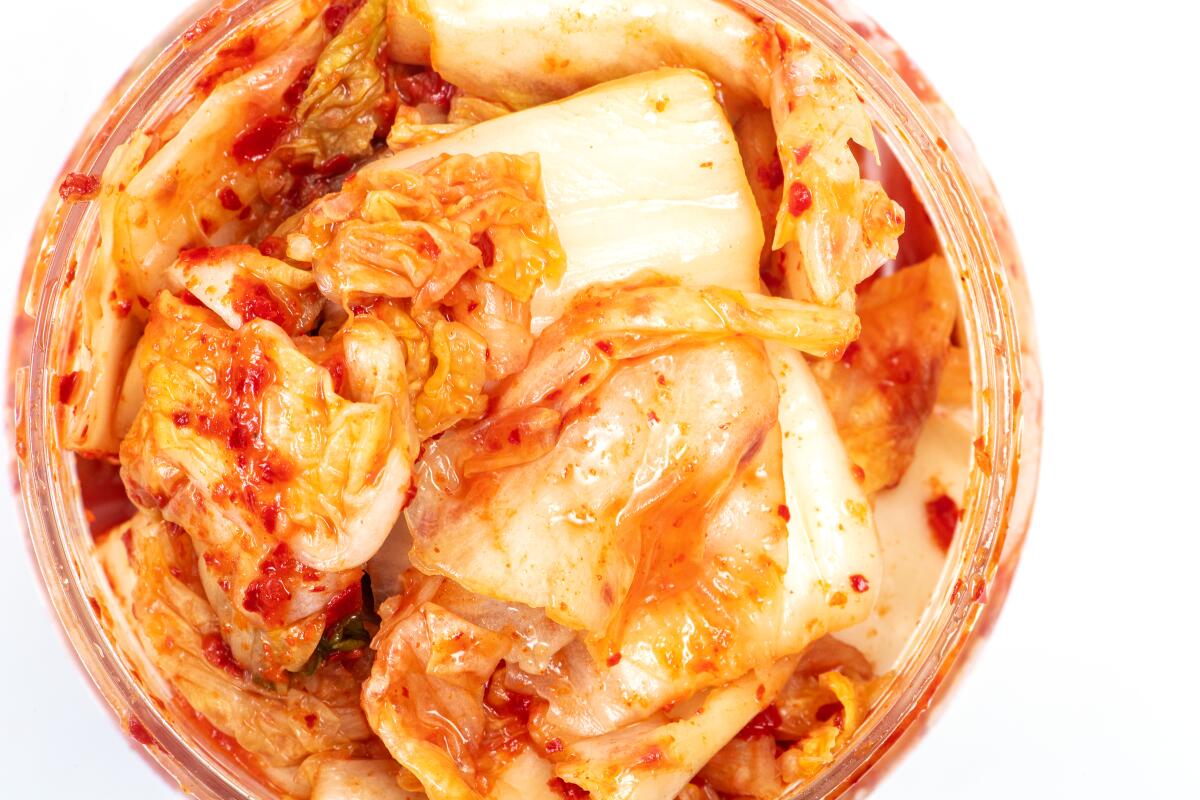
The fermented vegetables known as kimchi are regarded with a great sense of pride in Korea. There’s a kimchi museum in Seoul and the Korean government has established a kimchi research facility — the World Institute of Kimchi in Gwangju — which houses hundreds of papers that study its effects on everything from obesity to hair growth.
“It is the most traditional Korean food,” Kimchi Nara owner Moo Seon Han said. Han, who is from Daegu and opened her Garden Grove kimchi shop in 2004, makes nine varieties of kimchi, including whole cabbage, chopped cabbage and sliced radish. She prepares batches of it every morning, cleaning the vegetables and seasoning them with a mixture of garlic, anchovy and shrimp sauce, hot chile, sugar, salt and rice flour.
“They never expire, and sometimes they taste different and better after a few months,” she said. Han recommends eating the kimchi on its own but says it can complement anything.
Kimchi Nara, 8769 Garden Grove Blvd., Garden Grove, (714) 530-5800
Pickled herring
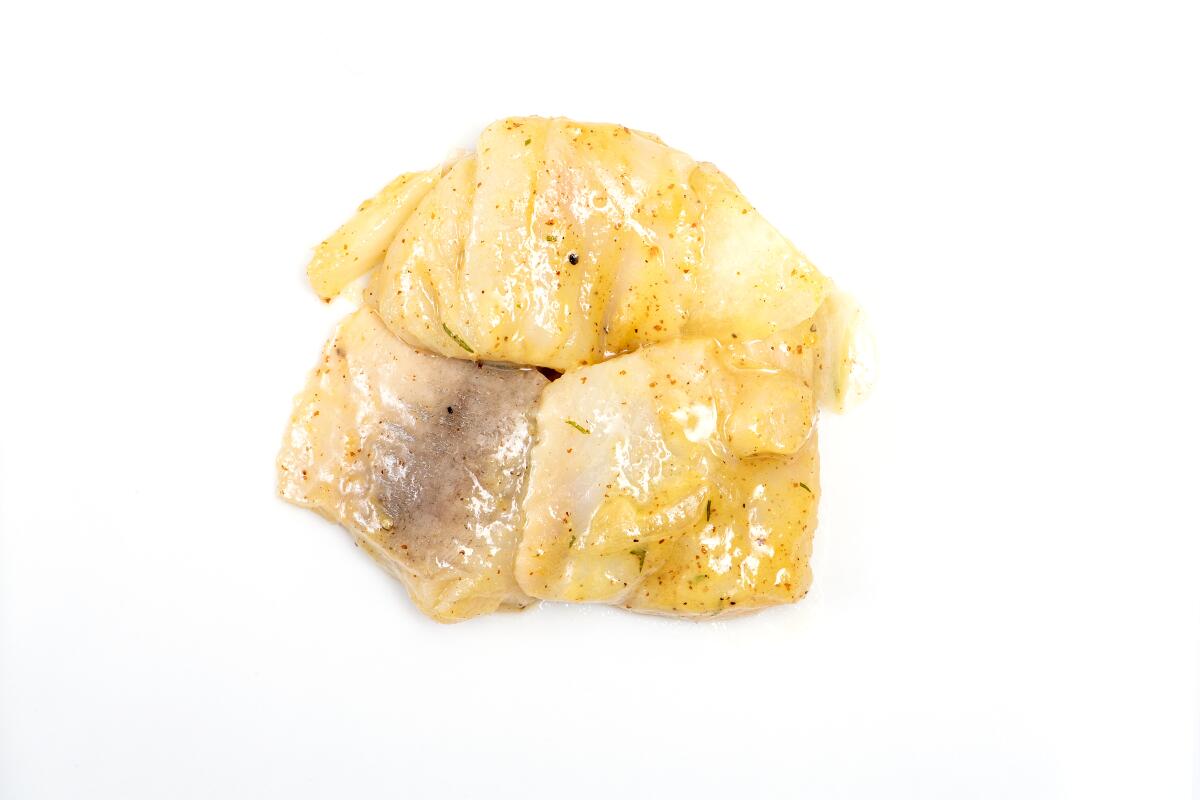
Lars Magnus Stefansson says his mom would often make pickled herring — using salt, vinegar, sugar and spices such as mustard seed, bay leaf and juniper berry — at their home in Sweden. When he and partner Arda Koca decided to open Gravlax, their Scandinavian restaurant in Culver City, they were hesitant to put herring on the menu, fearing the strong fish flavor would turn off diners. But it quickly became one of the most requested dishes.
Because it’s difficult to get fresh herring in L.A., Koca and Stefansson buy pickled herring from Canada, then serve it in a mustard sauce or a beet sauce. The herring, sweetened and tamed by the beets, is served with crisp Swedish crackers, potato salad and pickled vegetables.
“You can have so many different variations,” Stefansson said. “You can serve it with sour cream and onions [and] some people do a blackcurrant herring. The sky is the limit.”
Gravlax, 12400 Washington Blvd., Los Angeles, (646) 812-3069, gravlaxla.com
More to Read
Eat your way across L.A.
Get our weekly Tasting Notes newsletter for reviews, news and more.
You may occasionally receive promotional content from the Los Angeles Times.
